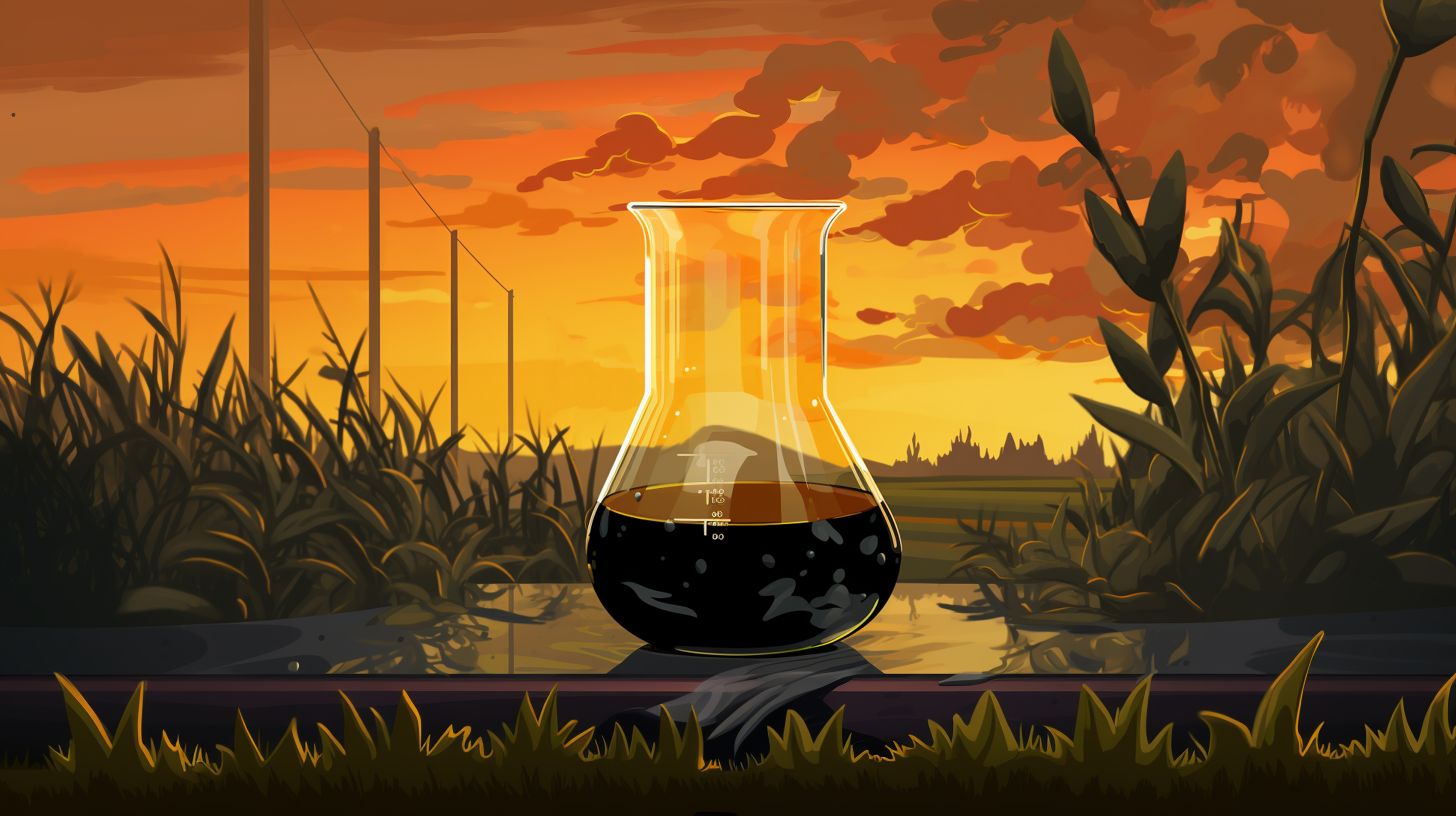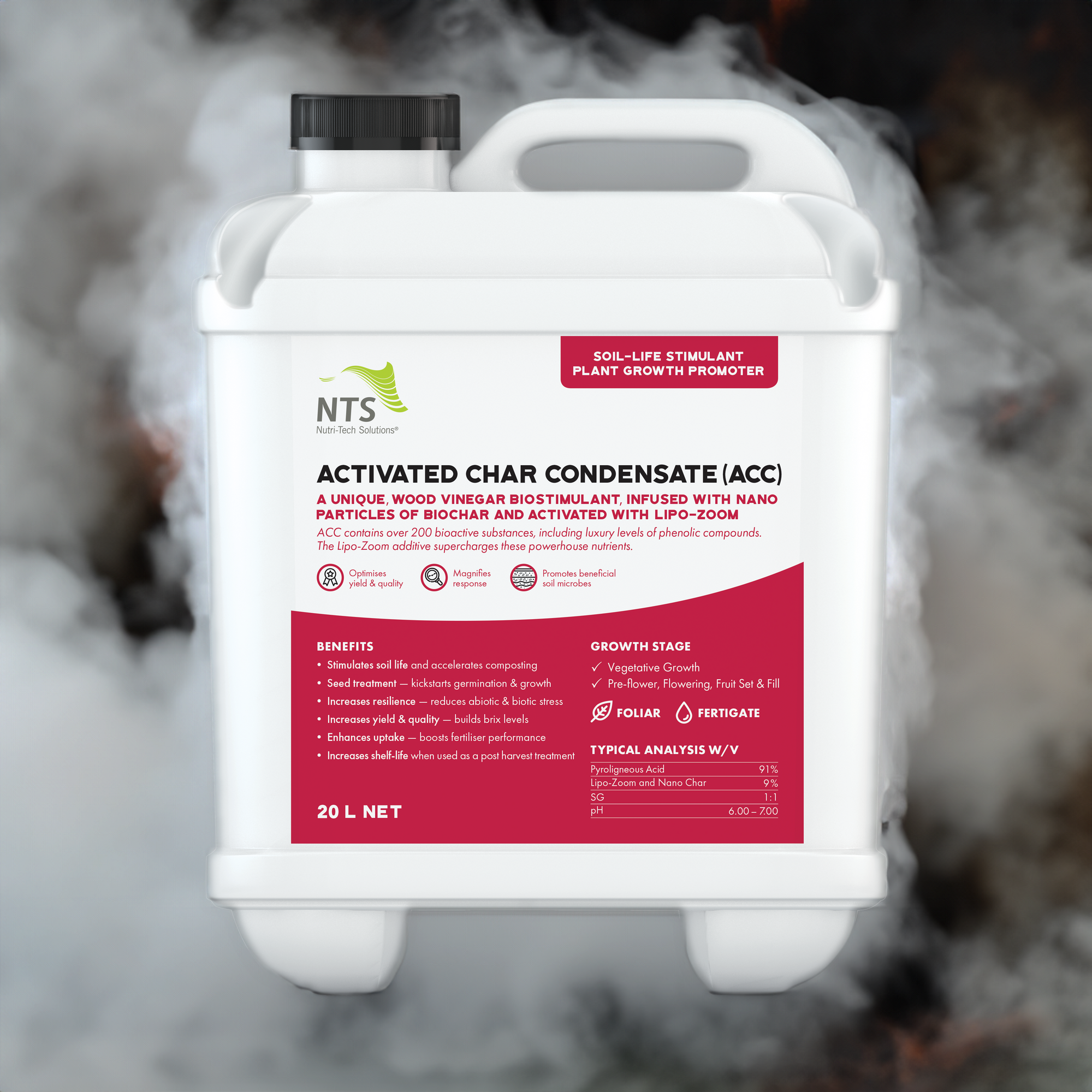
This is actually important news. understand that the manufacture of biochar in particular and also charcoal produces a nasty product properly called pyroligneous acid, also called wood vinegar and even mistaken by some as a crude oil. yuck!
I was anticipating that it was a harmful biproduct. this says completely otherrwise. obviously mother nature was this figured out.
all this means biochar production can actually capture all the volitiles in the process of using the heat itself below 600 degrees.. Even a simple recyling quench is good enough to get it all while we only escape the CO2 without smoke. Easy Peasy folks.
Ihave posted manytimes thgat this protocol will globally revolutionize all agriculture simply because activated carbon hold all nutrients until a biolgical comes along to get it. Tropical soils no longer leach.
now we can add back all the nasties to jump start the blend as well. biochar needs to be mixed with soil in order to produce a working charge.
Activated Char Condensate (ACC) - The Wonders of Wood Vinegar
Jun 29, 2023 • 10 min read
https://blog.nutri-tech.com.au/activated-char-condensate-acc-the-wonders-of-wood-vinegar/
Wood Vinegar is a natural byproduct of biochar production, which involves a process of pyrolysis within a closed container. The smoke condensate can be captured during this process, representing a dense concentration of everything that was present in the wood or other plant material that was burned. There is a slight parallel here with essential oils. In that context, a host of phytochemicals from the seeds, flowers, or roots are extracted and concentrated to address multiple maladies. Similarly, this smoke condensate offers potential benefits for soils and plants.
There are over 200 bioactive compounds in the smoke condensate, one of which involves acetic acid; hence, the name, wood vinegar. Some of these compounds are similar to those found in fulvic acid, but there are other exciting actives that are unique to wood vinegar. This includes the strong smell of smoke, which may confer its own benefits, as we will discuss later. Some of these key actives include phenolic compounds, esters, alkanes, and ketones, which are collectively referred to as pyroligneous acid.
Wood vinegar is destined to become an essential in Nutrition Farming®, and here are seven reasons why:
1) Kickstarting with smoke.
Some of you may be aware of the potential for smoke to trigger the germination of the seeds of many Australian natives, following a bushfire. Recent research has determined that there is a group of bioactive components in smoke responsible for this kickstart, named “Karrikins”. Interestingly, this word is derived from the Australian Aboriginal word for “smoke” which is “karrik”. This is appropriate, as this ancient race has used fire as a management and regenerative tool for tens of thousands of years. It turns out that these Karrikins affect more than just germination. They have a structure and signalling capacity very similar to plant growth hormones called strigolactones and, as such, they influence physiological features in multiple species.

In a Karrikin study published in The Journal of Plant Growth Regulators in 2019, carrots grown from pre-soaked seeds were bigger, heavier, and had higher carotene levels than untreated plants.
Another notable study by Michal Antalya et al., published online in the journal “Plants”, titled, “Karrikins as novel plant growth regulators in Agriculture”, summarises the considerable potential of this stimulant. What I found truly exciting is the fact that seed treatment was shown to provide up to three months of multiple benefits. This is such good news because seed treatment is already a strategy that delivers the greatest cost to benefit ratio (bang for your buck) of anything you can do on the farm, and it just got better!
Seeds should be treated with a 1:200 to 1:400 solution of wood vinegar. Some studies have soaked the seed for 24 hours, while others have utilised more user-friendly seed treatment strategies, like spraying the diluted wood vinegar on the seed while it is on the auger.
2) Pest Protection Potential
The second major benefit from smoke condensate, or the slang name “wood vinegar”, relates to a profound potential for pest protection. I'm talking here about insects, slugs, snails, and root knot nematodes, so that might make you prick up your ears. There is an urgency to reduce our dependence on farm chemicals, as we recognise the environmental and health impacts. This impetus has been fast-tracked in recent months due to the drastic increase in farm chemical prices.
In this context, the Nutrition Farming® approach is a pragmatic one, where we aim to minimise these inputs while gradually learning to live without them. There is an impressive Chinese study which showed that the inclusion of wood vinegar with the insecticide carbosulfan dramatically enhanced the capacity of this chemical to kill leafhoppers on rice. As this is a fairly toxic input, anything that reduces the amount applied is beneficial for everyone.

One study, comparing the pesticide potential of wood vinegar produced from different types of wood, found that the most effective version involved wood from the neem tree. Apparently, some of the insecticidal capacity of this tree is transferred to the smoke condensate during burning. The study revealed that a 1:100 dilution of wood vinegar was most effective for insect repulsion.
The most damaging parasite in chicken farming is the poultry red mite. It caused over five hundred million dollars in damage last year, just in Europe. On average, an infected bird houses over 300,000 of these nocturnal blood suckers. They are primary vectors for diseases like salmonella, avian flu, and Lyme disease, which can also spread to humans. Mite-infected birds have up to ten times the death rate of clean chickens, and the mite has developed resistance to control chemicals.
A paper published in the Japanese Journal of Poultry Science reported remarkable, non-toxic control of poultry mites by spraying birds and bedding with a 1:500 dilution of wood vinegar. This is excellent news for commercial chicken producers and for anyone with a chicken coop wondering why some of their chickens are bleeding, with half their feathers plucked. This is a classic sign of mite infestation. Now, there's a sustainable solution!
Wood vinegar has shown potential biological activities as larvicidal, pupicidal, and causing adult deformities against the common housefly. The treated insect species showed deformities at larval, pupal, and adult stages, and the adult lifespan was decreased.
However, most of the insect repulsion claims come from Asia, and I cannot find many studies supporting these claims. The Thai government recommends a 1:500 dilution for rice borer and cabbage butterflies, and a 1:300 dilution for corn pests. I wonder whether increases in plant health and resilience might be contributing to some of that insect resistance.
Research supports the nematocidal capacity of wood vinegar. Wood vinegar kills nematodes directly, and it boosts nematode trapping fungi to further combat the most destructive of all pests. The Thai agricultural department suggests a dilution of 1:500 around the base of tomato crops and 1:200 for nematodes in strawberries.
In 2009, Lindqvist et al. reported control against both slugs and snails, and many anecdotal reports from around Australia support these findings.
3) Fertiliser Enhancement
Fertiliser enhancement is another major claim, and this magnification can also apply to farm chemicals. Many have used wood vinegar as the acidifier to optimise the solution pH to maximise the efficiency of glyphosate. There are some alkaline inputs where this practice will be counterproductive, but the majority of farm chemicals favour acidity.
The mode of action of this enhancement effect is proposed to be related to changing the structure of water to make it a better carrier. A 1:500 dilution of wood vinegar can supposedly reduce the cluster value of water by 66%, and this smaller mass means the water is more easily absorbed. This is a claim that pops up on every wood vinegar site, but I can find no supporting science. However, I have used wood vinegar on my own farms for the past two years, and there is no doubt that a magnifying effect is happening. It is suggested that fertilisers and farm chemicals can be reduced by 50% due to this enhancement phenomenon. Certainly, in one Malaysian study, the fertigated NPK was dramatically more effective when 10% wood vinegar was combined with the fertiliser fed through irrigation. That equated to roughly 2 litres for every 20 kgs of soluble fertiliser fertigated.
It was truly interesting to find a study that reported this productive synergy with other inputs was particularly potent when beneficial anaerobes (fermented fertilisers) were combined with wood vinegar. I will be combining Beneficial Anaerobic Microbes (BAM) and wood vinegar together on my research farms in the future. It makes sense that these two super-productive, acidic inputs might support each other. In fact, a recently published paper might further explain the productive synergy between wood vinegar and BAM. It turns out the Purple Non-Sulphur bacteria, a key beneficial anaerobe found in BAM, produce a substance called ALA that has PGP qualities. Wood vinegar increases the production of ALA when it is added to BAM.
4) Fungal disease protection
There is substantial research supporting the fungicidal potential of wood vinegar. Published research by Calermsan et al., in 2009, and Jung et al., in 2007, has confirmed efficacy against some of the most destructive fungal diseases. These include Alternaria, Rhizoctonia, Sclerotinia, Pythium, and Phytophthora.
In trials on Rhizoctonia and Sclerotinia in cucumbers, there was over 80% control of these diseases compared to the control.
In 2020, Wardoyo et al., reported an 89% control of anthracnose on capsicum plants using a 1:200 dilution of wood vinegar.
5) Microbial stimulation
This is arguably the biggest gain from my perspective, because I have personally monitored some really significant soil life improvements on my own farms. When we consider the fact that wood vinegar is used at a 1:100 ratio to boost composting, the microbial connection is clear. There have been several studies reporting higher enzyme activity in treated soils, and it has also been shown that an associated reduction in ammonia volatilisation reduces the toxic effect of heavy metals. Both of these qualities are supportive of soil life.
A Turkish study in 2019 reported significant increases in the enzyme phosphatase, following wood vinegar treatment. This is a great outcome in terms of sponsoring the release of locked-up phosphate in the soil.
In terms of general biostimulation of soil life, a Chinese study published in The Journal of Pharmaceutical and Chemical Research reported substantial increases in bacterial numbers and diversity when wood vinegar was applied at 1:500 and 1:300 to the soil.
A 2019 Italian study showed significant improvements in soil life counts at lower rates (0.5%), but at 5%, there was an initial sterilising effect.
I will shortly share my experience monitoring with a microbiometer following wood vinegar applications on our research farms.
6) Post Harvest Treatment
Let's now look at wood vinegar as a post-harvest treatment to prolong the shelf-life of fruit and vegetables. In several published studies, it was shown that when fruits are dipped for two minutes in water containing 5 ml per litre of wood vinegar, this treatment reduces the rotting rate, the water loss, the respiratory rate and significantly delays the ageing of the fruit. I'll try that on my apples in a couple of weeks when we start harvesting. I'll keep you posted.

7) Plant growth promotion and quality enhancement
The Thai Government is strongly supportive of this input. They suggest application rates between 1:500 and 1:1000 will stimulate plant growth, increase brix levels, counter excessive nitrogen, improve plant metabolism, boost photosynthesis, and increase crop resilience.
That should be enough to get most people excited. Perhaps you can now understand why I believe wood vinegar is set to become part of the essential toolkit in regenerative agriculture.
However, it doesn’t stop there, there is still more…
Wood vinegar can be used at a 1:50 ratio to seriously reduce odour issues associated with confined animals and, according to the Thais, it can be added to animal feed at the rate of 1:250 to boost rumen performance and increase feed utilisation.
There are a few claims I’ll be testing in the coming months.
Activated Char Condensate (ACC)- a genuine breakthrough
Now, to conclude this section, I would like to promote the new wood vinegar product that we have just released. We have imported and tested products from all over the world, and there is quite a difference in performance between different products. This variation may be based on differences in production techniques and the raw material used to create the Biochar.
There is a very good Australian product that was our benchmark for this research, as I am always intent that any product we introduce must be at least as good as anything currently available. My goodness, it was a challenge to better this product, but we eventually developed a super productive wood vinegar with a couple of points of difference.
This new NTS product is called Activated Char Condensate (ACC), and it has a couple of unique characteristics:Wood vinegar is typically the colour of urine, but our product is black. This relates to the presence of nanoparticles of Biochar in the solution. This inclusion is far too fine to clog filters, but if you check the research, you will find several studies highlighting the benefits of wood vinegar combined with Biochar. I am convinced that this feature helps with much-needed fungal stimulation of our soils.
Secondly, we have incorporated an activator into our wood vinegar to further boost performance. We are soon to unveil a revolutionary new input, dubbed Lipo-Zoom. This is a phospholipid material that envelops the mother material, facilitating its efficient infiltration into the cell. This operates on the same principle as Liposomal vitamin C, which is by far the most effective means of oral supplementation for this crucial protective vitamin. The cell membranes of plants and humans comprise phospholipids, and a 'like attracts like' phenomenon is at work when this fat bubble encases a nutrient or a chemical. The cell membrane, through which various elements pass into the cell, beckons enticingly, fostering an uptake increase of whatever the lipid is carrying.
Lipo-Zoom is incorporated into the ACC formula to further amplify the benefits of wood vinegar.
Activated Char Condensate (ACC) - A Breakthrough Wood Vinegar Formulation from NTS
I highlighted our outcomes in relation to microbial stimulation. That's where Activated Char Condensate (ACC) truly excels. In one experiment, on my subtropical research farm, the control had a commendable microbiometer reading of 509, with a fungi to bacteria ratio of 37% fungi to 63% bacteria.
Upon the application of five millilitres of ACC per litre of water, per square metre, there was a dramatic surge in soil life. The subsequent reading was an astonishing 1743, and the fungi to bacteria ratio completely flipped. Those soils now contained 71% fungi and 29% bacteria. This application rate is much higher than would generally be applied to soil. It equates to 50 litres per hectare, but I simply wanted to observe the outcome. It seems to me that in a world striving to boost fungal numbers in the pursuit of stable carbon sequestration, this could be very promising news.
From a yield standpoint, in that same experiment, the wood vinegar treated soil outperformed the control by 31%.
Alright, I trust that is sufficient to pique your interest. I recommend you experiment with this input under your specific soils and conditions. Then, possibly, you will echo my belief that wood vinegar is set to become an indispensable tool in Nutrition Farming®.

No comments:
Post a Comment